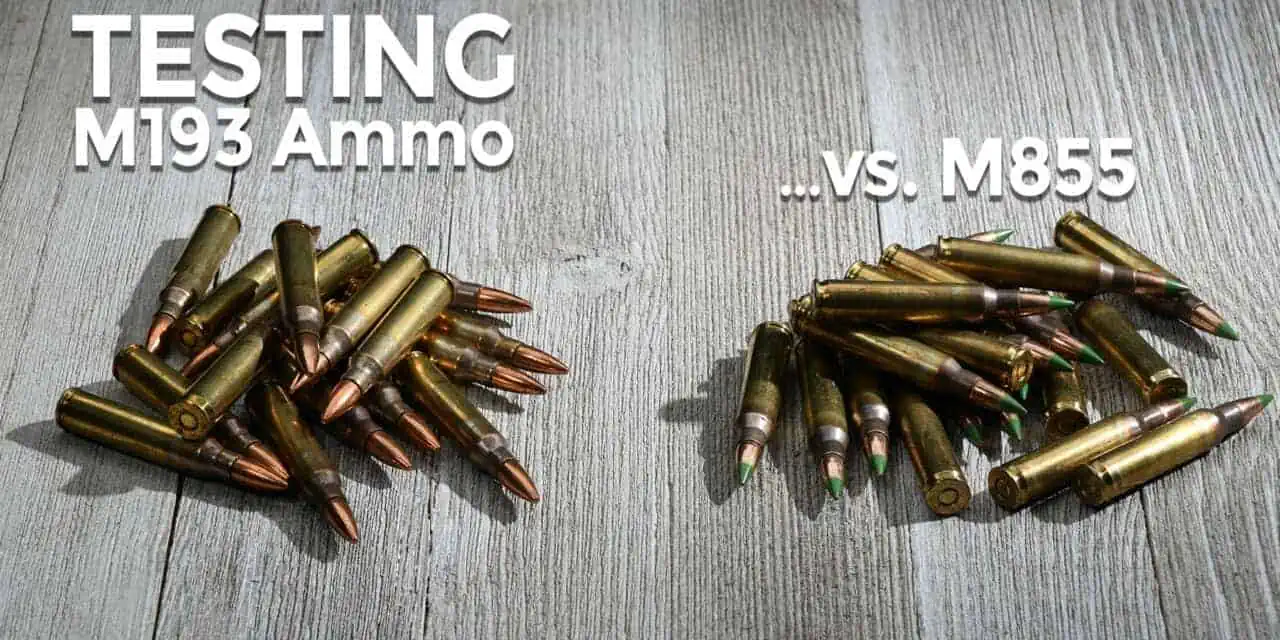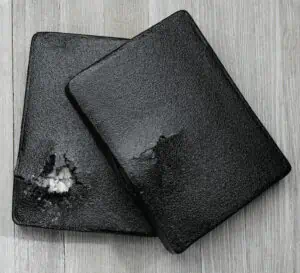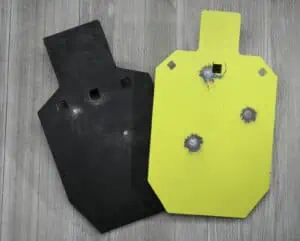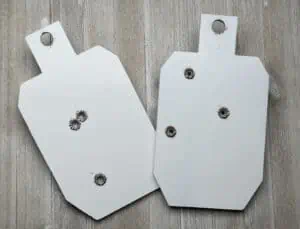M855 vs M193: What’s The Difference?
The AR-15 rifle is now one of America’s most popular guns, and for good reason. It’s lightweight, accurate, and easy to shoot, and you can turn it into almost any type of gun you want, thanks to its modular construction. An AR can also shoot a wide variety of 5.56mm ammunition. Some guns are set up to run rocket-fast 40gr varmint loads. Other rifles prefer 77gr thumpers that work well with suppressors. Today, we’ll be evaluating two of the more popular types of 5.56mm ammo for the AR, the 62 grain M855 vs. the 55 grain M193.
A Brief History of the M-16 Rifle and M-4 Carbine
The M-16 rifle and M-4 carbine in service with military and law enforcement as well as the AR-15 in your gun safe all trace their roots back to one man: Eugene Stoner. Stoner was an engineer and machinist with a background in creating aircraft parts. In the mid-50’s, he used his knowledge of aircraft aluminum and mass production techniques to create the AR-10 rifle, chambered in 7.62mm. When the U.S. military chose the M-14 rifle over the the AR-10 for its next service rifle, Stoner downsized the gun to shoot a variant of the commercial .223 Remington round. The U.S. Air Force accepted that design as the M-16 rifle.
The modular construction of the AR-15 meant that many different variants of the rifle would soon pop up. Civilian gun owners bought semi-automatic versions, called AR-15s, while the military soon altered the barrel length and twist and changed out the stock, handguard, and other components to create many different kinds of guns, all based around Stoner’s original design. The M-16 soon morphed into the M-16A1. It was then redesigned with a shorter barrel and tighter twist rate as the M4 carbine. Militaries all over the world now use variants it.
What is M193 Ammunition
M193 is the U.S. military’s designation for its standard 55 grain copper-jacketed lead 5.56x45mm ammunition. The copper on the outside of the round encases the lead inside. This makes it a prime example of an FMJ, or full metal jacket round. M193 served as the M-16 rifle’s primary round for many years, and it was quite accurate with the 1:12 twist rate on the 20 inch barrel of that gun. In the field, though, there were complaints that the M193’s lightweight 55 grain projectile didn’t cause significant damage after it penetrated even light cover, such as a car door or plywood. So the search began for a round that could be an effective man-stopper after penetrating typical barriers found in the field.
M855 vs M193 Ammo
FN Herstal developed M855 ammunition in the mid-1970’s to address the M193’s penetration issues. Originally called the SS109 round, the 5.56x45mm round became NATO standard issue and was called M855 by the U.S. There are many differences in a round of M855 vs M193. The first is that M855 has a heavier bullet. The 62 grain bullet inside the M855 round is heavier than the 55 grain bullet found in M193.
7 grains may not seem like a lot (it’s just 0.016 of an ounce, after all), but that small amount of weight can make a big difference in how the bullet flies towards the target. A lot of that difference is due to the twist rate of the barrel you fire them from. Both the M193’s 55 grain bullet and the M855’s 62 grain bullet work well with a barrel that has a 1 in 8 twist rate. This means that the rifle’s barrel has grooves in it that make one complete turn every eight inches.
A 1 in 7 twist rate is what the military uses in most AR-pattern rifles, so both rounds will shoot well in today’s guns. However, older rifles, such as early AR-15’s with a 20 inch barrel, may have a 1 in 12 twist rate. This can cause hiccups with the heavier 62 grain round.
It’s What’s Inside That Counts
The other big difference between M855 and M193 ammo is inside the bullets themselves. Places like Lake City manufacture M193 ammunition like most full metal jacket ammunition. It has a lead core with a copper jacket to prevent the lead from clogging up the barrel’s rifling. They build M855 slightly differently. Shooters often call it “green tip.” The reason why is readily apparent when you look at the round itself. The green tip on the bullet denotes that M855 has a steel core on the bullet. This helps it penetrate light cover, such as a car door.
Because of that steel core, there have been attempts to classify M855 ammunition as “armor piercing ammunition.” At first glance, the steel core on a round of M855 would help it punch through body armor. But body armor, especially Level IV body armor that is rated to resist rifle bullets, is quite tough.
We set up a simple test to find out if the steel core in M855 is truly “armor piercing” versus the more conventionally designed M193 round.
Penetration Testing M855 vs. M193
We set up three tests to find out the armor piercing qualities of M855 relative to M193. The first was two plates of Level IV body armor. The second was two plates of AR500 hardened steel. And the third was two plates of A36 mild steel. We shot them all at a distance of 100 yards. We shot each pair of targets with a round of M855 ammunition and a round of M193 ammunition. Our team fired a home built AR-15 with a 16” 1 in 8 twist barrel, topped with a Swampfox 4-16×44 mil-dot scope for optimal accuracy. Average velocity for the ammunition (measured at the muzzle) was 3136 fps for the M193 round and 2925 fps for the M855.
M855 vs M193 Test #1: Body Armor Penetration
The Level IV plates stopped both the conventional 55 grain M193 FMJ bullet and the 62 grain steel-cored M855 round. Neither round penetrated the armor, although both of them did leave significant bulges on the back side of the armor plate. Of course, it would hurt quite a bit to be shot with either round. However, neither penetrated enough to cause significant damage to someone wearing rifle-resistant body armor. When it comes to punching through body armor, there really is no difference between the steel-cored M855 and the M913 with its conventional, full metal jacket construction.
Test #2: AR500 Steel Plates
Manufacturers specifically harden AR500 steel to resist impacts and abrasions. We commonly use it as a bullet-resistant plate in body armor. The bullet-resistant qualities of AR500 steel also make it a great choice for the targets we shoot on our ranges. At 100 yards, there was no difference in penetration between the M855 and the M193. Both rounds splattered against the hardened steel and did not affect the surface in any meaningful way. If you need to poke holes in hardened steel, you probably want to use something other than a 5.56mm round, even if it is M855.
Test #3: Mild Steel Plates
Mild steel is the most common type of steel us civilians encounter. Car doors, refrigerators, steel-reinforced doors, pretty much everything we think of as “steel” is made from mild steel. M855 had remarkably different results when shot at mild steel versus M193 ammo. The steel core of the M855 round punched right through the mild steel and embedded itself in the dirt of the backstop. The lead and copper M193, on the other hand, carved out big divots into the target but did not penetrate it.
Conclusions
The results of our tests are rather clear. The so-called “armor-piercing” M855 round doesn’t actually pierce armor. Rather, it does the job it’s supposed to do: punch holes in cover that might stop the M193 round. However, there is a caveat about using the M855 round on a day-in, day-out basis. Many ranges (especially indoor ranges) ban M855 due to concerns about bullets punching holes in the backstop or metal targets. In that case, conventional 62 grain FMJ ammo without the steel core should be your round of choice. The ammo needs of armed citizens vary somewhat from that of the military or law enforcement. Choose your ammo with a purpose in mind.







How thick was the A36 steel?
5/8ths inch